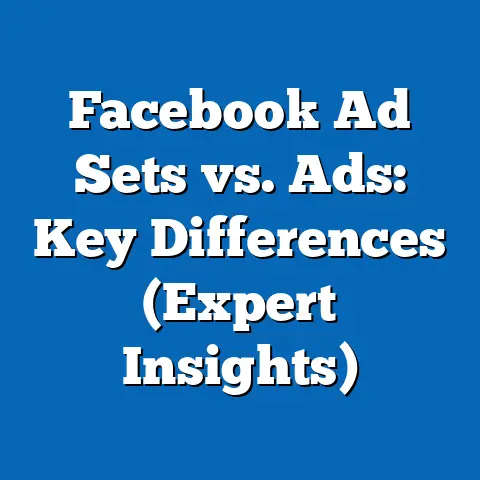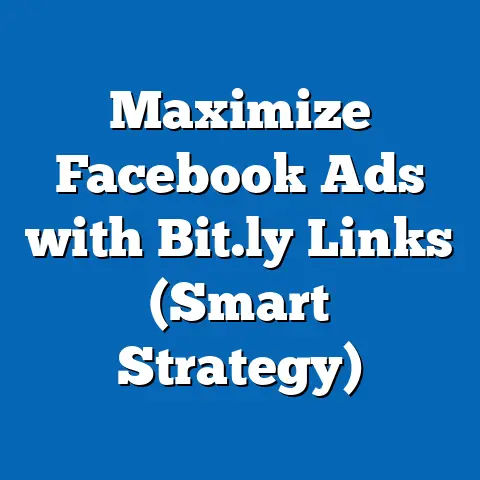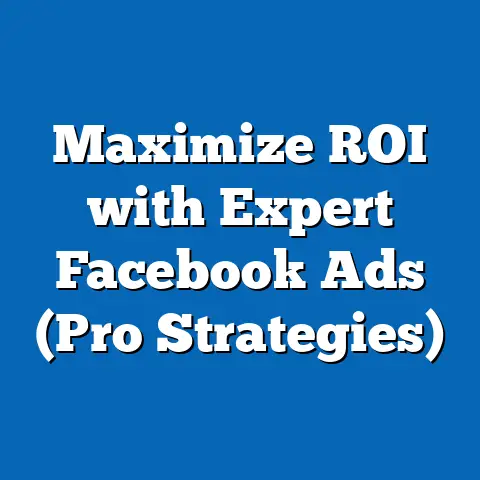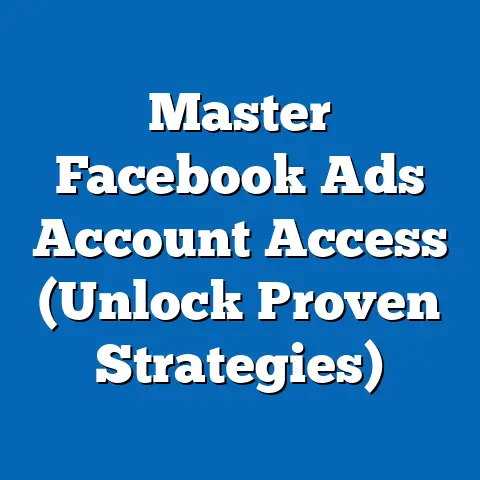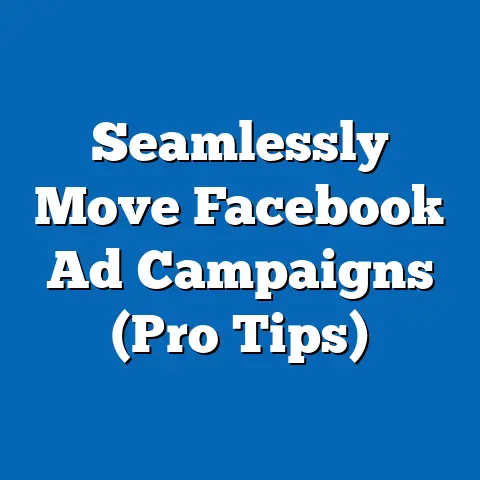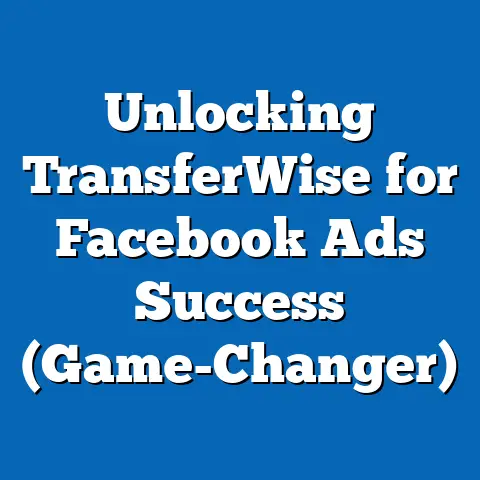Regain Control of Facebook Ads (Expert Strategies Revealed)
Facebook advertising can feel like navigating a turbulent sea. One minute you’re riding a wave of engagement, the next you’re battling against rising costs and dwindling returns. I’ve been there, wrestling with algorithms and chasing elusive conversions. But here’s the truth: you can regain control. Seasonal trends, often overlooked, are a powerful lever to boost your campaigns.
Seasonal advertising is not just about slapping a Santa hat on your logo during Christmas. It’s about understanding the nuanced shifts in consumer behavior, tailoring your messaging, and optimizing your budget to capitalize on these predictable peaks.
In this guide, I’m going to share expert strategies that will help you regain control of your Facebook Ads, leveraging seasonal trends to unlock unprecedented results. I’ll walk you through everything from identifying the right trends for your business to crafting compelling ad creatives and optimizing your budget for maximum impact. Let’s dive in and transform those advertising challenges into opportunities.
Understanding Seasonal Trends in Facebook Advertising
Seasonal trends are the predictable fluctuations in consumer behavior and market demand that occur throughout the year. Think about the surge in travel bookings during summer, the back-to-school shopping frenzy in August, or the holiday gift-giving bonanza in December. These aren’t just calendar events; they’re powerful drivers of consumer spending and engagement.
Why do seasonal trends matter for Facebook Ads? Because they offer a unique opportunity to connect with your audience when they’re already primed to buy. By aligning your ad campaigns with these trends, you can tap into heightened demand, increase relevance, and ultimately, drive better results.
I remember working with a local bakery that struggled to attract customers during the slow summer months. We decided to run a Facebook campaign highlighting their refreshing iced coffee and summer-themed pastries. The results were remarkable – a 30% increase in foot traffic compared to the previous summer. This experience taught me the power of leveraging seasonal trends to boost even the most local businesses.
Here are a few examples of how seasonal trends can impact Facebook Ads:
- Increased Click-Through Rates (CTR): Ads that are relevant to the current season are more likely to catch the attention of users scrolling through their feeds.
- Lower Cost Per Click (CPC): By targeting users who are actively searching for seasonal products or services, you can often reduce your advertising costs.
- Higher Conversion Rates: When your ads align with the needs and desires of your audience during a specific season, they’re more likely to convert into sales.
Statistics and Case Studies:
- According to a study by Deloitte, holiday retail sales in the US are projected to reach over \$1.3 trillion in 2024. This highlights the immense potential of seasonal advertising during the holiday season.
- A case study by Facebook showed that businesses that used seasonal targeting strategies saw an average increase of 25% in ad recall.
Identifying Relevant Seasonal Trends:
The key is to identify the trends that are most relevant to your industry and target audience. Here are some tips:
- Use Google Trends: This free tool allows you to track search interest over time, helping you identify seasonal peaks for specific keywords.
- Analyze Your Past Data: Look at your sales data from previous years to identify patterns and trends.
- Monitor Social Media: Pay attention to what your audience is talking about on social media to identify emerging trends.
- Consider Niche Trends: Don’t just focus on major holidays. Think about niche trends that are relevant to your specific industry, such as “Dry January” for health and wellness businesses or “Wedding Season” for event planners.
Takeaway: Understanding seasonal trends is the first step towards regaining control of your Facebook Ads. By identifying the right trends and aligning your campaigns accordingly, you can tap into heightened demand and drive better results.
Next Step: Start researching seasonal trends that are relevant to your business and begin planning your upcoming campaigns.
Crafting Targeted Ad Campaigns
Targeting is the heart and soul of effective Facebook advertising. It’s about showing your ads to the right people at the right time. And when it comes to seasonal advertising, targeted campaigns are even more crucial. You need to ensure that your message resonates with your audience during specific seasons.
I once worked with an e-commerce store selling outdoor gear. Their summer campaigns were consistently underperforming. After analyzing their data, we realized they were targeting a broad audience with generic messaging. We decided to create separate campaigns targeting specific segments, such as hikers, campers, and beachgoers, with tailored ads highlighting relevant products for each activity. The result? A 40% increase in summer sales.
Audience Segmentation:
The first step is to segment your audience based on demographics, interests, behaviors, and other relevant factors. This allows you to create highly targeted ads that speak directly to the needs and desires of each segment.
Advanced Targeting Options:
Facebook offers a range of advanced targeting options that can be particularly useful for seasonal advertising:
- Custom Audiences: These allow you to target users who have already interacted with your business, such as website visitors, email subscribers, or customers. You can create custom audiences based on various criteria, such as website traffic, engagement with your Facebook page, or a list of email addresses.
- Lookalike Audiences: These allow you to target users who are similar to your existing customers or website visitors. Facebook uses its vast database to identify users who share similar demographics, interests, and behaviors with your seed audience.
- Behavioral Targeting: This allows you to target users based on their online behavior, such as purchase history, travel habits, or interests in specific categories. During the holiday season, for example, you could target users who have shown an interest in gift-giving or holiday travel.
Creating Tailored Ad Content:
Once you’ve segmented your audience and chosen your targeting options, you need to create ad content that resonates with each segment during the specific season. This means tailoring your messaging, visuals, and call-to-actions to reflect the spirit of the season and the needs of your target audience.
Examples of Successful Targeted Campaigns:
- A clothing retailer targeting college students with back-to-school ads featuring trendy outfits and discounts.
- A travel agency targeting families with summer vacation packages to popular destinations.
- A jewelry store targeting men with ads promoting Valentine’s Day gifts for their partners.
- A home decor company targeting homeowners with ads featuring festive decorations for the holiday season.
Takeaway: Targeted ad campaigns are essential for maximizing the impact of your seasonal advertising efforts. By segmenting your audience, leveraging advanced targeting options, and creating tailored ad content, you can ensure that your message resonates with the right people at the right time.
Next Step: Analyze your existing audience data and identify key segments for your upcoming seasonal campaigns. Experiment with different targeting options and create tailored ad content for each segment.
Leveraging Creative Ad Formats
In the crowded landscape of Facebook feeds, standing out is paramount. Creative ad formats are your secret weapon for capturing attention and driving engagement, especially during the visually stimulating seasonal periods. Think beyond the static image and embrace the power of motion, interactivity, and storytelling.
I recall working with a small bookshop that wanted to promote their summer reading list. Instead of a simple image ad, we created a carousel ad featuring close-up shots of each book cover, accompanied by intriguing snippets from the stories. The carousel format allowed users to explore multiple options and ultimately led to a significant increase in book sales.
Exploring Different Ad Formats:
Facebook offers a variety of ad formats, each with its own strengths and weaknesses:
- Image Ads: These are the simplest and most common ad format. They’re great for showcasing a single product or service.
- Video Ads: These are highly engaging and can be used to tell a story, demonstrate a product, or create brand awareness.
- Carousel Ads: These allow you to showcase multiple products or services in a single ad. They’re great for e-commerce businesses and businesses with a diverse product line.
- Collection Ads: These are designed for mobile shopping and allow users to browse and purchase products directly from the ad.
- Instant Experience Ads: These are full-screen, interactive ads that load instantly when a user clicks on them. They’re great for creating immersive brand experiences.
The Importance of Creative Storytelling:
During peak seasons, users are bombarded with advertising messages. To stand out, you need to tell a compelling story that resonates with your audience on an emotional level. This means crafting ad copy that is engaging, informative, and relevant to the season. It also means using visuals that capture the spirit of the season and align with your brand messaging.
Tips for Creating Engaging Ad Copy and Visuals:
- Use High-Quality Images and Videos: Invest in professional-quality visuals that are visually appealing and relevant to your target audience.
- Write Compelling Ad Copy: Use clear, concise language that highlights the benefits of your product or service.
- Include a Strong Call-to-Action: Tell users what you want them to do, whether it’s visiting your website, making a purchase, or signing up for your email list.
- Use Seasonal Themes and Imagery: Incorporate seasonal colors, themes, and imagery to make your ads more relevant and engaging.
- A/B Test Different Creative Elements: Experiment with different ad copy, visuals, and call-to-actions to see what works best for your target audience.
Case Studies and Examples:
- A beverage company using video ads to showcase their refreshing summer drinks during a beach party.
- A fashion retailer using carousel ads to showcase their latest holiday collection.
- A travel agency using Instant Experience ads to create an immersive virtual tour of a popular vacation destination.
Takeaway: Creative ad formats are a powerful tool for capturing attention and driving engagement during seasonal campaigns. By exploring different ad formats, crafting compelling stories, and using high-quality visuals, you can create ads that stand out from the crowd and resonate with your target audience.
Next Step: Experiment with different ad formats and creative elements to see what works best for your business. A/B test different versions of your ads to optimize your performance.
Optimizing Ad Spend and Budgeting Strategies
Budgeting for Facebook Ads can be tricky, especially during seasonal peaks when competition intensifies and advertising costs tend to rise. It’s crucial to have a clear strategy in place to ensure that you’re maximizing your return on investment (ROI).
I remember advising a startup during the Black Friday season. They were excited to run a big campaign but didn’t have a clear budget or optimization strategy. They ended up spending a lot of money without seeing a significant return. This experience taught me the importance of careful planning and data-driven optimization.
Setting Clear Objectives:
The first step is to set clear objectives for your campaigns. What do you want to achieve? Are you looking to increase brand awareness, drive website traffic, generate leads, or boost sales? Your objectives will influence your budget allocation and your choice of bidding strategies.
Budget Allocation:
How much should you spend on your Facebook Ads? There’s no one-size-fits-all answer, but here are some factors to consider:
- Your Industry: Some industries are more competitive than others, which means you’ll need to spend more to get noticed.
- Your Target Audience: The size and engagement of your target audience will influence your advertising costs.
- Your Campaign Objectives: If you’re looking to drive conversions, you’ll need to allocate a larger budget than if you’re just looking to increase brand awareness.
- Your Budget: Of course, your budget will ultimately determine how much you can spend on your Facebook Ads.
Monitoring Ad Performance Metrics:
It’s crucial to monitor your ad performance metrics regularly to see how your campaigns are performing. Key metrics to track include:
- Click-Through Rate (CTR): This measures the percentage of users who click on your ad after seeing it.
- Cost Per Click (CPC): This measures the average cost you pay for each click on your ad.
- Conversion Rate: This measures the percentage of users who take a desired action after clicking on your ad, such as making a purchase or signing up for your email list.
- Return on Ad Spend (ROAS): This measures the revenue you generate for every dollar you spend on advertising.
Making Data-Driven Adjustments:
Based on your ad performance metrics, you can make data-driven adjustments to optimize your campaigns. This might involve:
- Adjusting Your Bids: If your CPC is too high, you can lower your bids. If your CTR is low, you can try improving your ad copy or visuals.
- Refining Your Targeting: If your ads aren’t reaching the right people, you can refine your targeting options.
- Optimizing Your Landing Page: If your conversion rate is low, you can try improving your landing page to make it more user-friendly and persuasive.
Scaling Up or Down Ad Spend:
During seasonal peaks, you might need to scale up your ad spend to capitalize on increased demand. However, it’s important to do this strategically. Don’t just blindly increase your budget without monitoring your performance. If you see that your campaigns are performing well, you can gradually increase your ad spend. If you see that your campaigns are underperforming, you might need to scale down your ad spend or adjust your strategy.
Takeaway: Optimizing ad spend and budgeting strategies are essential for maximizing your ROI during seasonal campaigns. By setting clear objectives, allocating your budget wisely, monitoring your ad performance metrics, and making data-driven adjustments, you can ensure that you’re getting the most out of your advertising dollars.
Next Step: Review your current budgeting and ad spend strategies and identify areas for improvement. Start tracking your ad performance metrics and make data-driven adjustments to optimize your campaigns.
Analyzing and Adapting Post-Campaign
The journey with Facebook Ads doesn’t end when the season does. In fact, the post-campaign analysis is one of the most critical steps in regaining control and setting yourself up for future success. It’s about dissecting what worked, understanding what didn’t, and using those insights to refine your strategy for the next seasonal push.
I once overlooked the importance of post-campaign analysis. I launched a successful holiday campaign but didn’t take the time to analyze the data. When the next holiday season rolled around, I made the same assumptions and repeated the same tactics, only to be disappointed by the results. That’s when I realized the value of learning from past experiences.
Key Performance Indicators (KPIs):
To effectively assess the success of your campaigns, you need to track the right KPIs. These might include:
- Reach and Impressions: How many people saw your ads and how many times they saw them?
- Engagement Rate: How many users interacted with your ads (likes, comments, shares)?
- Website Traffic: How much traffic did your ads drive to your website?
- Conversion Rate: How many users took a desired action after clicking on your ad?
- Cost Per Acquisition (CPA): How much did it cost you to acquire a new customer or lead?
- Return on Ad Spend (ROAS): How much revenue did you generate for every dollar you spent on advertising?
Gathering Insights from Performance Data:
Once you’ve collected your performance data, it’s time to analyze it and gather insights. Look for patterns and trends. What types of ads performed best? Which targeting options were most effective? What landing pages had the highest conversion rates?
Using Insights to Inform Future Campaigns:
The insights you gather from your post-campaign analysis should inform your future campaigns. For example, if you find that video ads performed better than image ads, you might want to focus on creating more video content. If you find that a specific targeting option was particularly effective, you might want to use it again in your next campaign.
The Value of A/B Testing:
A/B testing is a powerful tool for refining your audience targeting and creative elements. It involves creating two versions of an ad (A and B) and showing them to different segments of your audience. By comparing the performance of the two versions, you can determine which one is more effective.
For example, you might want to A/B test different headlines, visuals, or call-to-actions. You can also A/B test different targeting options.
Takeaway: Analyzing and adapting post-campaign is crucial for regaining control of your Facebook Ads and setting yourself up for future success. By tracking the right KPIs, gathering insights from performance data, and using A/B testing, you can refine your strategy and improve your results over time.
Next Step: Review your past seasonal campaigns and analyze your performance data. Identify areas for improvement and start planning your next campaigns with a data-driven approach.
Conclusion
Regaining control of your Facebook Ads is an ongoing journey, not a destination. By understanding seasonal trends, crafting targeted ad campaigns, leveraging creative ad formats, optimizing your budget, and analyzing your results, you can turn advertising challenges into opportunities.
Remember, seasonal advertising is not just about slapping a festive theme on your ads. It’s about understanding the nuanced shifts in consumer behavior and tailoring your messaging to resonate with your audience during specific periods.
I encourage you to take proactive steps in regaining control of your Facebook Ads by applying the strategies I’ve shared in this guide. Start planning your next seasonal campaigns with renewed confidence and strategic insight.
And remember, the world of Facebook advertising is constantly evolving. Stay curious, keep learning, and never stop experimenting.
Call to Action:
Subscribe for more insights on Facebook advertising strategies and follow for upcoming articles that delve deeper into specific tactics and case studies. I’m here to help you navigate the ever-changing landscape of Facebook Ads and achieve your advertising goals.

